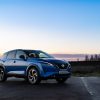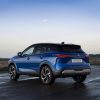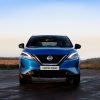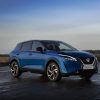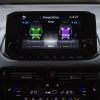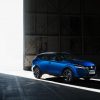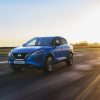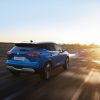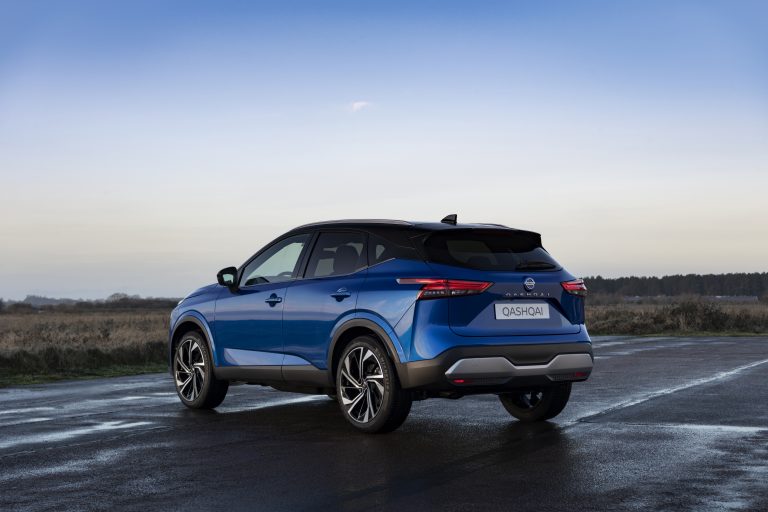
NEWS COPY
Nissan has taken the wraps off its latest version of the UK’s most produced car – in a welcome boost to the manufacturing industry.
More than three million Qashqais have rolled off the production line in Sunderland over the past 14 years.
Laid out in a line, the cars would stretch more than 7,500 MILES – enough to cover every mile of UK motorway three times over.
The third generation of the family car, which has been designed in London, will be going on sale later this year and could bring an end to the irritating bumps and shunts that occur in supermarket car parks.
Engineers have developed ‘Flank Protection’, which alerts the driver if they are at risk of contact with an object on the side of the vehicle as they move into a gap.
And trolley prangs could be avoided thanks to its ‘Moving Object Detection’ alert, which applies the brakes if it detects a moving obstacle nearby as the driver is reversing.
The Qashqai will also be fitted with ProPILOT with Navi-link, a new system designed to reduce fatigue while driving – a contributory factor in an estimated 20 per cent of road accidents.
It enables the car to automatically accelerate and brake within a single lane on the road and can read road signs to reduce or increase speeds depending on the changing limit, meaning the driver doesn’t need to adjust cruise control manually.
The tech can also communicate with blind-spot radars to intervene with a steering correction to help prevent a possible collision as the driver changes lanes.
For added safety, Nissan’s engineers have developed an advanced headlight system that adapts the shape of the beam according to the road conditions and other road-users.
The beam is divided into 12 individual elements that selectively deactivate upon detection of an oncoming vehicle.
This allows it to project a brighter beam further and wider, but the shape effectively changes so oncoming road-users will not be dazzled.
Nissan unveiled the new Qashqai at an event in Paris today (Thurs).
It is available with a choice of two 1.3-litre petrol engines boasting 138bhp and 156bhp and featuring Mild Hybrid technology.
The car also sees the European debut of ‘e-POWER’, known as series hybrid, where a petrol engine charges a battery powers and electric motor which turns the wheels. The efficient system drives like an electric vehicle, but without the concerns of range anxiety or access to a charger.
Gianluca de Ficchy, chairman, Nissan Africa, Middle East, India, Europe and Oceania (AMIEO) Region, said: “The new Qashqai is going to change what customers can expect from a family car.
“Comfort, refinement and technology will be comparable with upper segment vehicles, while the driving experience will satisfy drivers and passengers alike.
“With Nissan’s bold e-POWER technology, we feel that customers will fall in love with the feeling of an electric powertrain, without the range concerns.”
The Qashqai has been designed in central London, with the engineering led by Nissan Technical Centre Europe in Cranfield, Beds.
And production will be in Sunderland, the UK’s biggest car production plant, which employs 6,000 people and has been the subject of more than £4 billion of investment since 1985.
Three million Qashqais have been sold in Europe, making it the continent’s most popular crossover, with 620,000 of these sold to UK customers.
jQuery(document).ready(function($) {
// We only want these styles applied when javascript is enabled
$(‘.gal_content’).css(‘display’, ‘block’);
// Initialize Advanced Galleriffic Gallery
var gallery = $(‘#thumbs_45229_1’).galleriffic({
delay: 3500,
numThumbs: 12,
preloadAhead: 12,
enableTopPager: false,
enableBottomPager: false,
imageContainerSel: ‘#slideshow_45229_1’,
controlsContainerSel: ‘#controls_45229_1’,
captionContainerSel: ‘#caption_45229_1’,
loadingContainerSel: ‘#loading_45229_1’,
renderSSControls: true,
renderNavControls: false,
playLinkText: ‘Play Slideshow’,
pauseLinkText: ‘Pause Slideshow’,
enableHistory: 0,
autoStart: 0,
enableKeyboardNavigation: true,
syncTransitions: false,
defaultTransitionDuration: 300,
onTransitionOut: function(slide, caption, isSync, callback) {
slide.fadeTo(this.getDefaultTransitionDuration(isSync), 0.0, callback);
caption.fadeTo(this.getDefaultTransitionDuration(isSync), 0.0);
},
onTransitionIn: function(slide, caption, isSync) {
var duration = this.getDefaultTransitionDuration(isSync);
slide.fadeTo(duration, 1.0);
// Position the caption at the bottom of the image and set its opacity
var slideImage = slide.find(‘img’);
caption.fadeTo(duration, 1.0);
},
onPageTransitionOut: function(callback) {
//this.hide();
setTimeout(callback, 100); // wait a bit
},
onPageTransitionIn: function() {
var prevPageLink = this.find(‘a.prev’).css({‘opacity’: ‘0.3’ , ‘display’ : ‘inline-block’, ‘cursor’ : ‘default’});
var nextPageLink = this.find(‘a.next’).css({‘opacity’: ‘0.3’ , ‘display’ : ‘inline-block’, ‘cursor’ : ‘default’});
// Show appropriate next / prev page links
if (this.displayedPage > 0)
prevPageLink.css({‘opacity’ : ‘1’ , ‘display’ : ‘inline-block’, ‘cursor’ : ‘pointer’});
var lastPage = this.getNumPages() – 1;
if (this.displayedPage < lastPage)
nextPageLink.css({'opacity' : '1' , 'display' : 'inline-block', 'cursor' : 'pointer'});
this.fadeTo('fast', 1.0);
}
});
/**************** Event handlers for custom next / prev page links **********************/
gallery.find('a.prev').click(function(e) {
gallery.previousPage();
e.preventDefault();
});
gallery.find('a.next').click(function(e) {
gallery.nextPage();
e.preventDefault();
});
});
ENDS


